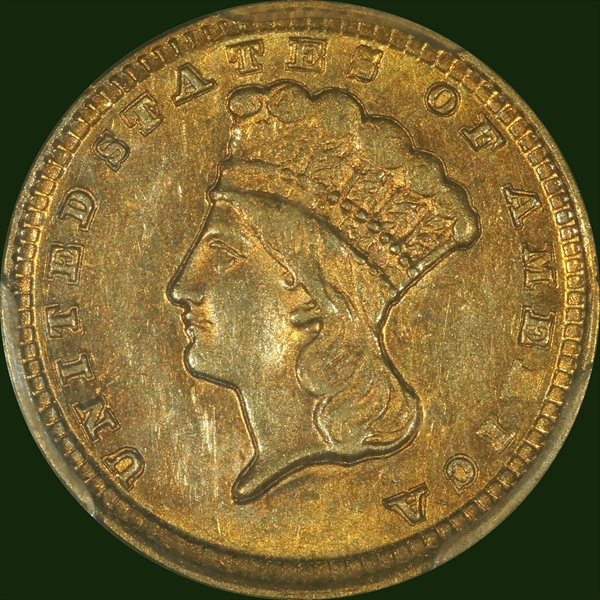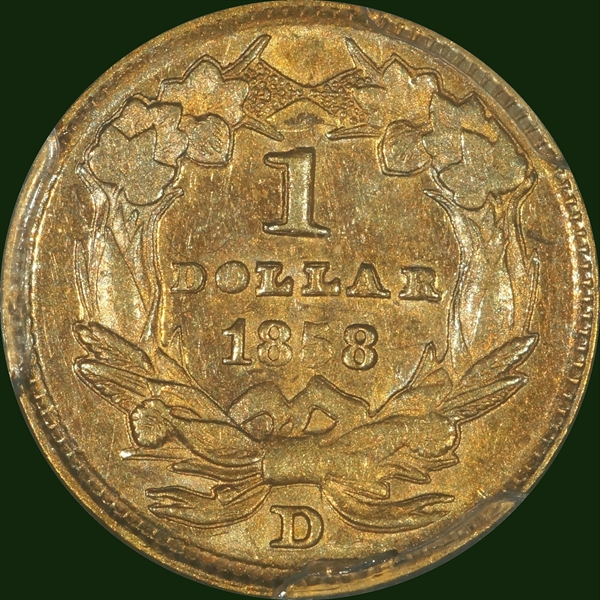1858-D G$1 MS61 认证号27401033, PCGS号7549
拥有者评论
1858-D G$1 MS61 PCGS. Variety 10-M. A single die pair is known for the scant mintage of 3,477 pieces. The present example has peach-gold toning around design elements while the high points and open fields are gunmetal-blue. No marks are visible, though a J-shaped strike-though, as made and often seen on the issue, is near the ED in UNITED. The strike is above average for a Dahlonega emission, with blending evident on the 5 in the date and the leaf above the right ribbon end. The reverse displays a triple set of clash marks from Liberty's profile
专家评论
David Akers (1975/88)
Always weakly struck, particularly on the hair and headdress of Liberty, and at the 85 of the date. On many specimens, in fact, the 8 and 5 are missing entirely. Despite its marginally lower mintage, the 1858-D is not as scarce as the 1857-D and, although it is almost impossible to obtain an 1858-D in full mint state (I have seen only two or three), VF and EF examples are reasonably obtainable.Doug Winter
The 1858-D is one of the more available Type Three gold dollars from this mint. Enough higher grade examples exist that it is a good date for the type collector seeking a single example of a Dahlonega Type Three gold dollar.The 1858-D gold dollar is reasonably easy to locate in Very Fine and Extremely Fine grades. It becomes scarce in the lower About Uncirculated grades and rare in choice About Uncirculated-55 and better. Mint State 1858-D gold dollars are rare, although a few exceptional examples are known.
STRIKE: This issue is found with a much better strike than the 1857-D. In fact, it is one of only two Type Three gold dollars from Dahlonega which can be regularly located with an average quality of strike. This is not to say that it is a well produced issue. The obverse is always weak on the tips of the bonnet, the hair near Liberty’s ear and eye and the lower portion of the hair. The lettering is thick and doubled and the second S in STATES and the R in AMERICA are often weak. The milling is fairly strong and distinguishable at most of the border areas. The reverse is more sharply struck. The upper part of the wreath is bold while the lower area, especially around the bow, tends to be weak. The first 8 and the 5 in the date are always weak and are sometimes nearly illegible. The DO in DOLLAR are filled and heavy and are faint as well. The milling is not as clear as on the obverse and is blurry. On the upper reverse, the denticles appear rusted.
SURFACES: Many examples are found with mint-made surface problems including laminations, lintmarks, planchet chips, and areas of roughness. On most, there is an incuse mark near the ED in UNITED which is the result of foreign matter adhering to the die during the striking process. Many have strong clashmarks at the centers. The poor quality of planchets used to strike 1858-D gold dollars, coupled with the fact that many show severe marks from circulation, makes it difficult to find a coin which does not have below average surfaces.
LUSTER: High grade examples show about average luster with a pleasing frosty texture. Many of the lower to medium grade pieces have impaired luster as a result of having been cleaned or dipped.
COLORATION: Uncleaned, original 1858-D gold dollars show coloration which ranges from bright yellow-gold to rich medium orange-gold. This is the easiest Type Three gold dollar from Dahlonega to locate with original color. However, such coins are becoming harder to locate and it will soon be nearly impossible to find an 1858-D dollar that has not been cleaned or dipped.
EYE APPEAL: Of the three relatively obtainable Type Three Dahlonega gold dollars (1857-D, 1858-D and 1859-D), the 1858-D is the most likely to be found with good eye appeal. Pleasing higher grade examples exist although many of these possess some surface problems.
PERSONAL OBSERVATIONS: There are enough very high grade (Mint State-62 and above) pieces known to suggest that a small hoard of 1858-D gold dollars may have existed at one time. Many of these have a similar appearance, with golden-orange coloration, a strong quality of strike and billowing luster.
DIE VARIETIES: A single variety is known.
Variety 10-M: On the obverse, the lettering is thick. The second S in STATES is joined solid. The date is well centered and evenly placed. The mintmark is large and well centered. Early die states show repunching on the mintmark; this eventually fades.
PCGS #
7549
设计师
James Barton Longacre
边缘
Reeded
直径
14.30 毫米
重量
1.70 克
铸币数量
3477
金属成分
90% Gold, 10% Copper
更高评级数量
19
评级较低的钱币数量
96
地区
The United States of America
价格指南
PCGS 数量报告
拍卖 - PCGS 评级的
拍卖 - NGC 评级的
稀有性和存量估计 了解更多
| 所有评级 | 175 |
| 60或以上 | 15 |
| 65或以上 | 2 |
| 所有评级 | R-7.2 |
| 60或以上 | R-9.3 |
| 65或以上 | R-9.9 |
| 所有评级 | 15 / 49 TIE |
| 60或以上 | 9 / 49 TIE |
| 65或以上 | 3 / 49 TIE |
| 所有评级 | 25 / 81 TIE |
| 60或以上 | 17 / 81 TIE |
| 65或以上 | 4 / 81 TIE |
状况普查 了解更多
| #1 MS65 PCGS grade |
| #1 MS65 PCGS grade |
|
#1 MS65 estimated grade
Jeffrey Fisher - Duke's Creek Collection - Heritage 4/2006:1490, $74,750 |
| #1 MS65 estimated grade |
| #5 MS64 PCGS grade |






















